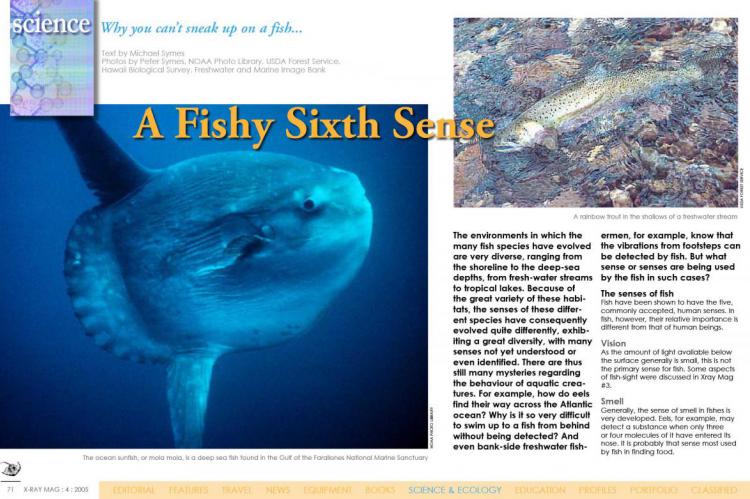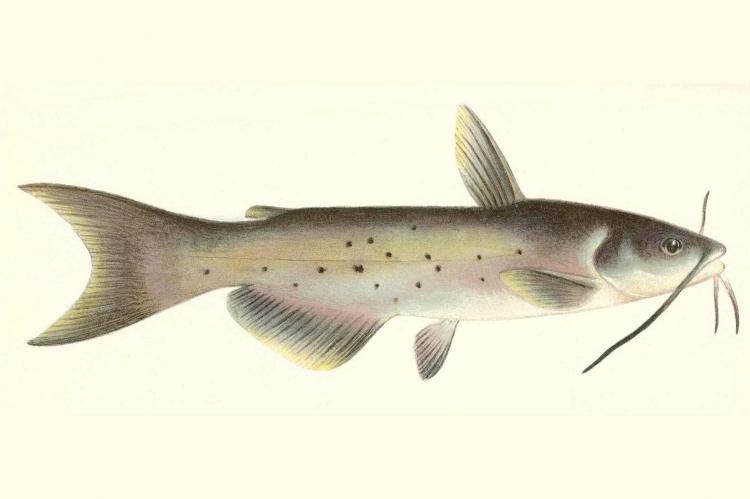A Fishy Sixth Sense
The environments in which the many fish species have evolved are very diverse, ranging from the shoreline to the deep-sea depths, from fresh-water streams to tropical lakes.
Because of the great variety of these habitats, the senses of these different species have consequently evolved quite differently, exhibiting a great diversity, with many senses not yet understood or even identified. There are thus still many mysteries regarding the behaviour of aquatic creatures. For example, how do eels find their way across the Atlantic ocean? Why is it so very difficult to swim up to a fish from behind without being detected? And even bank-side freshwater fishermen, for example, know that the vibrations from footsteps can be detected by fish. But what sense or senses are being used by the fish in such cases?
The senses of fish
Fish have been shown to have the five, commonly accepted, human senses. In fish, however, their relative importance is different from that of human beings.
Vision
As the amount of light available below the surface generally is small, this is not the primary sense for fish. Some aspects of fish-sight were discussed in X-Ray Mag #3.
Smell
Generally, the sense of smell in fishes is very developed. Eels, for example, may detect a substance when only three or four molecules of it have entered its nose. It is probably that sense most used by fish in finding food.
Hearing
Hearing in fish is not very well understood, but seems mostly to be used for simple distance perception and sound source location.
Taste
Taste buds in fish are mainly located in the mouth, but also in the skin covering the head, body fins, barbels and lips. No reponse is obtained when a barbel is touched with an inert glass tip, for example, but an immediate response is obtained when it is touched with a morsel of food.
Touch
Fish have a fine tactile sense, as is shown, for example, by certain catfish who can use their barbels almost as humans feel with their fingers.
However, good as some of these senses might be, none of them can account for even simple phenomena such as the detection of the vibrations from footsteps. Fish must therefore have at least one other sense which enables them to detect low frequency vibrations. Such a sense is located in their lateral line.
The lateral line
The lateral-line system is easy to observe in most fishes. There is usually only a single lateral line on each side of the body, but many variants of the typical lateral line may occur. For example, on the sides of the Belonidae (Needle Fish), the lateral line runs very low on the sides. On some species the lateral line may be incomplete, or it may also be interrupted, meaning that it ends and then recommences after a gap, as in some of the Labridae (Wrasse) species. And in a number of families the lateral line may be absent altogether.
The lateral line consists of a linear series of sensory cells or neuromasts. In many fishes, the neuromasts can also extend along the fish’s head as well as sides, although these are not always as obvious. These neuromasts are situated in a mucus-filled canal, situated just under the skin, which is in direct contact with the surrounding water through pores in the skin or scales. The incoming stimuli from the neuromasts are fed into a nerve parallel to the canal which then feed the stimuli to the fish’s central nervous system.
The neuromasts can be thought of as very sensitive hydrodynamic transducers that can detect water disturbances. They consist of a base of sense cells with sensory hairs (cilia) that project into the canal. These hairs are capped with a gel-like cupula. Movement of the mucus in the canal, caused by flow of water, makes the cupola bend. This in turn causes bending of the hairs, which stimulate the sense cells, thus generating minute electrical signals which pass along nerve fibres to the brain.
There are actually two main types of neuromast: canal neuromasts, where the water displacements are transferred to the canal fluid via pore openings, and superficial neuromasts, which are directly exposed to the flowing water. In either case, when the neuromasts are at rest, they send a continuous series of nerve impulses to the central nervous system.
In the case of the canal neuromasts, variations in water pressure between different pores along the canal cause a directional movement of the mucus through the canal. When pressure either increases or decreases due to a disturbance near a fish, the nerve impulse pattern changes, the fish registers the change, and takes appropriate action. In the case of the superficial neuromasts it is the drag of the water past the cupola that causes them to bend. The degree of this bending is directly related to the water velocity, i.e. to the velocity of the fish relative to the velocity of the water.
Similar to the human inner ear
For those with some knowledge of human anatomy, it will be clear that the structure of the cupola is homologous to the crista ampullaris of the human inner ear. Bending of the cupola by water currents and that of the crysta ampullaris by disturbance of the endolymph of the semi-circular canals causes excitation of sensory cells of both organs. Gerard (1936) inferred that the inner ear of vertebrates has phylogenically derived from a primitive lateral line system.
So, the lateral line can be considered as a sort of higher hearing sense, reacting to certain types of pressure changes in the surrounding water, just as the human ear reacts to pressure changes in the surrounding air. However, while the lateral line is a linear system of receivers, the ear functions just as a single receiver, although covering a range of frequencies. It does improve matters, though, that we do have two of them, giving stereo-directional hearing.
What can this sense be used for?
The lateral line system obviously greatly expands the area of tactile perception by making it possible for the fish to interpret its environment without actually touching an object. The lateral-line thus helps the fish in a number of ways.
Rheotaxis
Rheotaxis is a behavioural orientation ...
Download the full article ⬇︎




